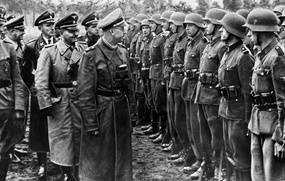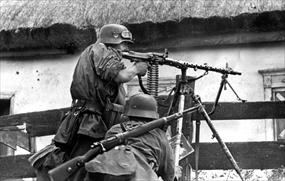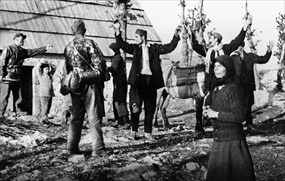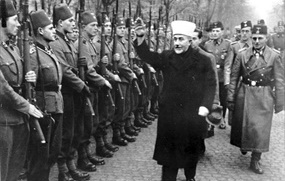FOREIGN VOLUNTEERS FILL NEW WAFFEN-SS DIVISIONS
Berlin, Germany • December 1, 1939
On this date, December 1, 1939, SS-Obergruppenfuehrer (senior group leader) Gottlob Berger opened the first Waffen‑SS Recruiting Office within the SS Main Office, which he had headed since 1938. The SS (short for Schutzstaffel, meaning protection squad) was the Nazi Party’s private paramilitary organization, originally a small squad of political thugs who provided security at Adolf Hitler’s Nazi Party meetings and rallies but grew into the nation’s foremost agency of security, surveillance, and terror within Germany and German-occupied Europe.
The remarkable growth of the Waffen‑SS (Armed SS) must be attributed to Berger rather than to his master, Reichsfuehrer‑SS Heinrich Himmler. The Waffen‑SS became the largest and most powerful of the three branches that comprised the SS. (The other branches were (1) the Allgemeine SS, or General SS, which oversaw the Party’s administrative and policing functions (notorious child agencies included the Gestapo, or secret state police, and the Sicherheitsdienst, or intelligence agency) and (2) the SS‑Totenkopfverbaende, or Death’s Head Units, which operated concentration and extermination camps.) By 1944 the Waffen‑SS had more than 800,000 men in 38 divisions serving in the field, rivaling even Germany’s regular armed forces, the Wehrmacht.
Initially Waffen‑SS recruits were drawn from within the Greater German Reich, which included Austria (1938) and Czechoslovakia (1939). Citizens of those incorporated areas were viewed as embodying Nazi concepts of blood and race purity and thus suitable enlistees. With the outbreak of war on September 1, 1939, and particularly after the German conquest of Denmark, Norway, the Benelux countries, and France (1940), Berger utilized the changed circumstances to draw new recruits to the Waffen‑SS. Recruiting offices were opened in Copenhagen, Oslo, Antwerp, and The Hague. Because Sweden and Switzerland were officially neutral, German embassies in those countries worked quietly with right-wing groups to add to the pool of potential recruits.
Recruitment increased in many areas in the wake of Operation Barbarossa, the German invasion of the Soviet Union in June 1941. Recruits could be drawn from the conquered Baltic states, Ukraine, and Belarus who wanted to eradicate Soviet hegemony from their homelands. There were 30 million Volksdeutsche (ethnic Germans born or living outside the Reich) from which to draw; e.g., in Hungary, Romania, and Slovenia, all of them Axis allies. Another pool consisted of men who were not committed Nazis but instead were staunchly anticommunist and hoped to eradicate the threat that Bolshevism posed to Western Europe. Finally, especially toward the end of the war, recruits could be, and were in fact, drawn from groups that in no way reflected Nazi ideas of blood and race; for instance, Turks, Muslims, and even juvenile delinquents and former or current criminals. In 21 of the 38 Waffen‑SS divisions foreign nationals were in the majority.
The end of the war saw a number of war crime trials, the most famous being the Nuremberg Trials (November 20, 1945, to October 1, 1946). In the first trial the International Military Tribunal declared the SS and all the agencies that comprised it, including the Waffen‑SS, criminal organizations for their heavy involvement in war crimes and crimes against humanity. Exempted were Waffen‑SS conscripts who were not given a choice in joining the ranks (about a third of the membership) and had not committed “such crimes.”
![]()
Foreign Waffen-SS Troops Assume Role in German War Machine
 |  |
Left: As early as 1938, Reichfuerher-SS Heinrich Himmler conceived of recruiting a pan-European army for the Third Reich on condition it was of sufficiently Germanic heritage and blood. In this photo the second-most powerful man in the Reich reviews members of the 14th Waffen-SS Grenadier Division Galicia (German, 14. SS‑Freiwilligen Division “Galizien”; after March 1945 it was known as the 1st Ukrainian Division of the Ukrainian National Army). In 1943 and 1944 a determined group of military volunteers from the area of Galicia (in today’s Ukraine), chiefly ethnic Ukrainians but with some Slovaks and Czechs (15,000–18,000 in all), were inducted into a combat division destined to fight on Germany’s Eastern Front. Their goal was to engage and destroy the Soviet hordes menacing their homeland and to counter Germany’s subjugation of their country. Although initially Galicia’s volunteers would serve under German officers in an SS‑sponsored military formation, in actuality the men of the Galicia division wanted to confront every hostile ideology—Eastern or Western—so as to secure a free and independent Ukraine. Although the postwar Nuremberg Trials declared the Waffen‑SS as a whole to be a criminal organization, the Galicia Division was not specifically found guilty of any war crimes by any Allied or national war tribunal or commission.
![]()
Right: The 5th SS Viking Division (German, 5. SS‑Panzerdivision “Wiking”) was recruited from foreign volunteers in Denmark, Norway, Sweden, Finland, Estonia, the Netherlands, and Belgium. The division, under the command of German officers, took part in Operation Barbarossa, advancing through Ukraine, where it committed war crimes against Jews and Ukrainian civilians. In an August 1941 incident recounted by one of the division’s Norwegian soldiers in 2013, “between 200 and 300 humans were burned inside [a church] . . . no one came out.” In the summer of 1942, the Viking division took part in Army Group South’s Case Blue offensive, which aimed at capturing Stalingrad and the Baku oilfields. It saw heavy fighting during Germany’s 1943–1945 withdrawal on the Eastern Front. In March and April 1945 the division committed more documented war crimes before it surrendered to U.S. forces in Austria on May 9, 1945.
 |  |
Left: The 7th SS Volunteer Mountain Division “Prince Eugene” (German, 7. SS‑Freiwilligen Gebirgs-Division “Prinz Eugen”) was a German mountain infantry division of the Waffen‑SS. It served only in German-occupied Yugoslavia. The core of its recruits were Serbs, but like most foreign-based Waffen‑SS divisions it used coercion to complete filling its ranks with Hungarians, Romanians, Volksdeutsche, and Croatians from the puppet Independent State of Croatia led by the fascist Ustaša (Ustashe) terrorist organization, thus giving the lie that the Waffen‑SS was an all-volunteer militia. The “Prinz Eugen” division was heavily involved in trying to suppress Marshal Josip Broz Tito’s Yugoslav Partisan resistance forces as shown in this photograph taken in Croatia. At the postwar Nuremberg Trials, in an August 6, 1946, morning session, it was stated that “The 7th SS Division, Prinz Eugen, is famed for its cruelty” and that “Wherever it passed—through Serbia, through Bosnia and Herzegovina, . . . or through Dalmatia—everywhere it left behind scenes of conflagration and devastation and the bodies of innocent men, women, and children who had been burned in the houses.” Of the division’s four commanders, one was shot to death in Romania, two were extradited to Yugoslavia, where they were convicted of war crimes and hanged, and one escaped from an internment camp before he too could be extradited to Yugoslavia to stand trial for his criminal behavior.
![]()
Right: Fugitive Palestinian nationalist and Grand Mufti of Jerusalem Haj Amin al-Husseini and Waffen‑SS Generalmajor Karl-Gustav Sauberzweig (to al-Husseini’s rear in fez) greet Bosnian SS volunteers of the 13th Waffen Mountain Division of the SS “Handschar” (1st Croatian) (German, 13. Waffen-Gebirgsdivision der SS “Handschar” (kroat. Nr. 1)) on an overcast November day in Europe in 1943. In February the men returned to their separatist Independent State of Croatia. The fascist puppet state encompassed almost all of modern-day Croatia, all of modern-day Bosnia and Herzegovina, as well as parts of Serbia. The 13th SS Division was the first non-Germanic Waffen‑SS division, and its formation marked the expansion of the Waffen‑SS into a multi-ethnic military force. Composed of Bosnian Muslims (ethnic Bosniaks) with some Catholic Croat and (briefly) Albanian Muslim soldiers and led mostly by German and Volksdeutsche officers and noncommissioned officers, the division of 17,000 fighters (at its height) earned a reputation for brutality and savagery, not only during counterinsurgency operations against Tito’s Yugoslav Partisans, but also through unspeakable atrocities committed against 5,000 mostly Serb and Jewish civilians during a reign of terror. In 1945, in full retreat ahead of the Red Army, division members who had survived their encounters with death or had not deserted and joined the Yugoslav Partisans became prisoners of the British Army in Austria. Subsequently, 38 officers were extradited to Yugoslavia to face criminal charges, some committed suicide (including Sauberzweig), and 10 were executed.
Waffen-SS: Militarized Standard Bearers for Nazi True Believers
![]()

 History buffs, there is good news! The Daily Chronicles of World War II is now available as an ebook for $4.99 on Amazon.com. Containing a year’s worth of dated entries from this website, the ebook brings the story of this tumultuous era to life in a compelling, authoritative, and succinct manner. Featuring inventive navigation aids, the ebook enables readers to instantly move forward or backward by month and date to different dated entries. Simple and elegant! Click
History buffs, there is good news! The Daily Chronicles of World War II is now available as an ebook for $4.99 on Amazon.com. Containing a year’s worth of dated entries from this website, the ebook brings the story of this tumultuous era to life in a compelling, authoritative, and succinct manner. Featuring inventive navigation aids, the ebook enables readers to instantly move forward or backward by month and date to different dated entries. Simple and elegant! Click 











